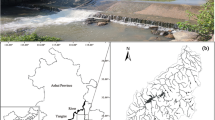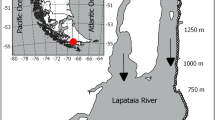Abstract
Habitat fragmentation by damming can affect the persistence of single species population and also coexistence of two or more species through intensified competition. This study examined the effects of habitat fragmentation by damming on the coexistence of two stream-dwelling salmonids: the southern form of white-spotted charr (Salvelinus leucomaenis japonicus) and the red-spotted masu salmon (Oncorhynchus masou ishikawae). We examined charr, salmon, and dam distributions in 27 streams of the Fuji River basin, central Japan. In the 1970s, there were streams with five sympatric and 22 allopatric populations (n = 13 for charr, n = 9 for salmon). However, from the 1970s to 2004, 356 impassable dams were constructed in the surveyed streams, and four of the five sympatric streams became allopatric. In the extant sympatric stream, more than 20 dams fragmented habitat. Species distributions were separated by dams (with decreasing altitude) in the following order: extirpation area, charr-dominant area, and salmon-dominant area. Within the uppermost sympatric section (i.e., situated between the dams), salmon congregated in the largest uppermost pool just below the dam; despite these conditions, salmon frequency increased in the downstream direction at the stream scale. The results suggest that habitat fragmentation threatens the coexistence of stream-dwelling charr and salmon at both the basin and stream scales. We believe that exclusion of one species by another is likely in extremely fragmented habitats with minimal gradients and little variation in physical conditions (through reduced stream gradient and increased sand sedimentation caused by damming). In addition, multiple sites of damming ensure that there are no salmonid refuges from the collapse of metapopulation structure. In such fragmented habitats, even small tributaries serve important roles, as they are used mainly by salmonid fry and juveniles. We propose that habitats of native salmonids should be maximized by reconnecting fragmented habitats as part of a broader management plan.





Similar content being viewed by others
References
Brown, J. H. & A. Kodric-Brown, 1977. Turnover rates in insular biogeography: effect of immigration on extinction. Ecology 58: 445–449.
Chesson, P. L., 1986. Environmental variation and the coexistence of species. In Diamond, J. & T. Case (eds), Community Ecology. Harper and Row, New York: 240–256.
Endou, S., J. Tsuboi & T. Iwata, 2006. Effects of damming on the persistence of white-spotted charr and red-spotted masu salmon populations. Japanese Journal of Conservation Ecology 11: 4–12. (In Japanese with English summary.).
Fausch, K. D., S. Nakano & K. Ishigaki, 1994. Distribution of two congeneric charrs in streams of Hokkaido Island, Japan: considering multiple factors across scales. Oecologia 100: 1–12.
Fausch, K. D., B. E. Rieman, J. B. Dunham, M. K. Young & D. P. Peterson, 2009. Invasion versus isolation: trade-offs in managing native salmonids with barriers to upstream movement. Conservation Biology 23: 859–870.
Fukushima, M., S. Kameyama, M. Kaneko, K. Nakano & E. A. Steel, 2007. Modelling the effects of dams on freshwater fish distributions in Hokkaido, Japan. Freshwater Biology 52: 1511–1524.
Hanski, I., 1998. Metapopulation dynamics. Nature 396: 41–49.
Hanski, I., J. Alho & A. Moilanen, 2000. Estimating the parameters of survival and migration of individuals in metapopulations. Ecology 81: 239–251.
Hasegawa, K. & K. Maekawa, 2008. Non-native brown trout invasion into native white-spotted charr sanctuary in Monbetsu stream, Hokkaido, Japan. Nippon Suisan Gakkaishi 74: 432–434. (In Japanese with English summary).
Hughes, R. M., L. Wang & P. W. Seelbach, 2006. Landscape Influences on Stream Habitats and Biological Assemblages. American Fisheries Society, Maryland.
Huxel, G. R. & A. Hastings, 1998. Population size dependence, competitive coexistence and habitat destruction. Journal of Animal Ecology 67: 446–453.
Huxel, G. R. & A. Hastings, 1999. Habitat loss, fragmentation, and restoration. Restoration Ecology 7: 309–315.
Imanishi, K., 1996. Charr and masu salmon. Heibonsha, Tokyo. (In Japanese).
Inoue, M. & S. Nakano, 1999. Habitat structure along channel-unit sequences for juvenile salmon: a subunit-based analysis of in-stream landscapes. Freshwater Biology 42: 597–608.
Inoue, M., S. Nakano & F. Nakamura, 1997. Juvenile masu salmon (Oncorhynchus masou) abundance and stream habitat relationships in northern Japan. Canadian Journal of Fisheries and Aquatic Sciences 54: 1331–1341.
Joy, M. K. & R. G. Death, 2001. Control of freshwater fish and crayfish community structure in Taranaki, New Zealand: dams, diadromy or habitat structure? Freshwater Biology 46: 417–429.
Kamata, T., 1979. The native stocks and transplantation of Amago salmon and Iwana trout in Shiga Prefecture. Land and Life in Shiga, Scientific Reports of Shiga Prefecture, pp. 615–622 (In Japanese with English summary.).
Koizumi, I. & K. Maekawa, 2004. Metapopulation structure of stream-dwelling Dolly Varden charr inferred from patterns of occurrence in the Sorachi River basin, Hokkaido, Japan. Freshwater Biology 49: 973–981.
Kubota, H., T. Nakamura, T. Maruyama & S. Watanabe, 2001. Number, dispersal and growth of juvenile Japanese charr and masu salmon in a small tributary of a Japanese mountain stream. Nippon Suisan Gakkaishi 67: 703–709. (In Japanese with English summary).
Lande, R., 1988. Genetics and demography in biological conservation. Science 241: 1455–1460.
Lande, R., 1998. Anthropogenic, ecological and genetic factors in extinction and conservation. Researches on Population Ecology 40: 259–269.
Luttrell, G. R., A. A. Echelle, W. L. Fisher & D. J. Eisenhour, 1999. Declining status of two species of the Macrhybopsis aestivalis complex (teleostei: cyprinidae) in the Arkansas River basin and related effects of reservoirs as barriers to dispersal. Copeia 1999: 981–989.
Miyasaka, H., S. Nakano & T. Furukawa-Tanaka, 2003. Food habit divergence between white-spotted charr and masu salmon in Japanese mountain streams: circumstantial evidence for competition. Limnology 4: 1–10.
Morita, K. & S. Yamamoto, 2002. Effects of habitat fragmentation by damming on the persistence of stream-dwelling charr populations. Conservation Biology 5: 1318–1323.
Morita, K. & A. Yokota, 2002. Population viability of stream-resident salmonid after habitat fragmentation: case study with white-spotted charr (Salvelinus leucomaenis) by an individual based model. Ecological Modeling 155: 85–94.
Morita, K., J. Tsuboi & H. Matsuda, 2004. The impact of exotic trout on native charr in a Japanese stream. Journal of Applied Ecology 41: 962–972.
Morita, K., S. H. Morita & S. Yamamoto, 2009. Effects of habitat fragmentation by damming on salmonid fishes: lessons from white-spotted charr in Japan. Ecological Research 24: 711–722.
Nakamura, T., 2001. Estimation of the distribution of genetically pure populations of the Japanese charr by inquiring survey. Journal of the Japan Society of Erosion Control Engineering 53: 3–9. (In Japanese with English summary).
Nakano, S., 1995. Competitive interactions for foraging microhabitats in a size-structured interspecific dominance hierarchy of two sympatric stream salmonids in a natural habitat. Canadian Journal of Zoology 73: 1845–1854.
National Research Council, 1996. Upstream. National Academy Press, Washington, DC.
Nehlsen, W., J. E. Williams & J. A. Lichatowich, 1991. Pacific salmon at the crossroads: stocks at risk from California, Oregon, Idaho, and Washington. Fisheries 16: 4–21.
Nishimura, K. & O. Kishida, 2001. Coupling of two competitive systems via density dependent migration. Ecological Research 16: 359–368.
Oohama, H. & J. Tsuboi, 2009. Do open type check dams have any function of fishway? Ecology and Civil Engineering 12: 49–56. (In Japanese.).
Peterson, D. P., B. E. Rieman, J. B. Dunham, K. D. Fausch & M. K. Young, 2008. Analysis of trade-offs between threats of invasion by nonnative brook trout (Salvelinus fontinalis) and intentional isolation for native westslope cutthroat trout (Oncorhynchus clarkia lewisi). Canadian Journal of Fisheries and Aquatic Sciences 65: 557–573.
Pringle, C. M., M. C. Freeman & B. J. Freeman, 2000. Regional effects of hydrologic alterations on riverine macrobiota in the New World: tropical–temperate comparisons. Bioscience 50: 807–823.
Sato, T., R. Sone, M. Arizono & M. Nagoshi, 2008. Effects of instream structures on Kirikuchi charr, southernmost population of genus Salvelinus, in a small mountain stream of Japan. Fisheries Science 74: 322–329.
Shaffer, M. L., 1981. Minimum population sizes for species conservation. Bioscience 31: 131–134.
Taniguchi, Y. & S. Nakano, 2000. Condition-specific competition: implications for the altitudinal distribution of stream fishes. Ecology 81: 2027–2039.
Thompson, P. D. & F. J. Rahel, 1998. Evaluation of artificial barriers in small Rocky Mountain streams for preventing the upstream movement of brook trout. North American Journal of Fisheries Management 19: 206–210.
Tsuboi, J. & S. Endou, 2008. Relationships between catch per unit effort, catchability, and abundance based on actual measurements of salmonids in mountain streams. Transactions of the American Fisheries Society 137: 496–502.
Warren, M. L. & M. G. Pardew, 1998. Road crossings as barriers to smallstream fish movement. Transactions of the American Fisheries Society 127: 637–644.
Winston, M. R. & C. M. Taylor, 1991. Upstream extirpation of four minnow species due to damming of a prairie stream. Transactions of the American Fisheries Society 120: 98–105.
Zippen, C., 1958. The removal method of population estimation. Journal of Wildlife Management 22: 82–90.
Acknowledgements
We are grateful to Colin Adams and two anonymous reviewers for their thoughtful comments, Tomoya Iwata for valuable suggestions on statistical analyses, and Y. Shibata for providing useful references. This work was supported by a Grant-in-Aid for Encouraged Research (Nos. 19922035, 20925005, and 21925006) to J. Tsuboi and Grant-in-Aid for Young Scientists B (No. 19780155) to K. Morita from the Japan Society for the Promotion of Science.
Author information
Authors and Affiliations
Corresponding author
Additional information
Guest editors: C. Adams, E. Brännas, B. Dempson, R. Knudsen, I. McCarthy, M. Power, I. Winfield / Developments in the Biology, Ecology and Evolution of Charr
Rights and permissions
About this article
Cite this article
Tsuboi, Ji., Endou, S. & Morita, K. Habitat fragmentation by damming threatens coexistence of stream-dwelling charr and salmon in the Fuji River, Japan. Hydrobiologia 650, 223–232 (2010). https://doi.org/10.1007/s10750-009-0076-3
Received:
Accepted:
Published:
Issue Date:
DOI: https://doi.org/10.1007/s10750-009-0076-3




